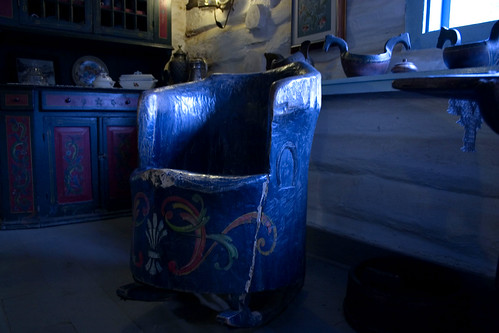Social Essays
Carved Norwegian Rocker

Before the outbreak of the first World War, about 800,000 Norwegians had arrived in the American Midwest. That was about a third of the population of Norway. No other country had exported so many of its people to America, except for Ireland.
The start of immigration in 1825 is considered the third wave of immigration to North America. Norsemen had set foot on North American soil centuries before.
The first Norseman thought to have landed in North America, Leiv Eiriksson, traveled through Greenland and landed somewhere between Cape Cod and Nova Scotia around A.D. 1003. The original Norwegian territory is believed to have encompassed the whole of the isle of Newfoundland. That was nearly five centuries before Columbus, as scholars are quick to point out. They continue to debate whether this early expedition ventured past the Canadian Maritime provinces.
The second wave of immigration to North America didn't happen until 1620 - the same year that the Mayflower landed at Plymouth Rock. In this wave, a Dano-Norwegian expedition laid claim to land on the Hudson Strait in Northern Canada.
Between 1630 and 1674, in what would later become New York State, 57 Norwegians settled in the colony of New Netherlands. The Dutch had colonized Albany, New York in 1624. Two years later, a Norwegian sailor named Sand would act as interpreter for Pieter Minuit, when he bought Manhattan Island from a small band of Canarsee Indians who were camping in New Amsterdam.
In 1636, a group of Norwegians had settled in the Swedish colony in the Delaware River Valley. Dutch landowner Jan Vanderbilt would marry a Norwegian woman, marking the beginning of one of the oldest and wealthiest families in the New World.
The start of immigration in 1825 is considered the third wave of immigration to North America. Norsemen had set foot on North American soil centuries before.
The first Norseman thought to have landed in North America, Leiv Eiriksson, traveled through Greenland and landed somewhere between Cape Cod and Nova Scotia around A.D. 1003. The original Norwegian territory is believed to have encompassed the whole of the isle of Newfoundland. That was nearly five centuries before Columbus, as scholars are quick to point out. They continue to debate whether this early expedition ventured past the Canadian Maritime provinces.
The second wave of immigration to North America didn't happen until 1620 - the same year that the Mayflower landed at Plymouth Rock. In this wave, a Dano-Norwegian expedition laid claim to land on the Hudson Strait in Northern Canada.
Between 1630 and 1674, in what would later become New York State, 57 Norwegians settled in the colony of New Netherlands. The Dutch had colonized Albany, New York in 1624. Two years later, a Norwegian sailor named Sand would act as interpreter for Pieter Minuit, when he bought Manhattan Island from a small band of Canarsee Indians who were camping in New Amsterdam.
In 1636, a group of Norwegians had settled in the Swedish colony in the Delaware River Valley. Dutch landowner Jan Vanderbilt would marry a Norwegian woman, marking the beginning of one of the oldest and wealthiest families in the New World.